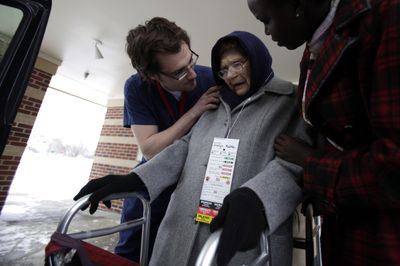Cracks in levee prompt evacuations

FARGO, N.D. – Officials ordered the evacuation of one neighborhood and a nursing home late Thursday after authorities found cracks in an earthen levee built to protect the area from the threat of the rising Red River.
Residents were not in immediate danger, and floodwaters were not flowing over the levee, Mayor Dennis Walaker said Thursday night. The evacuation was being enforced as a precaution.
Officers were going door to door to the roughly 40 homes in the River Vili neighborhood and were evacuating Riverview Estates nursing home. The number of residents at the nursing home wasn’t immediately clear.
Authorities across the river in Moorhead, Minn., also stepped up evacuations Thursday. They recommended that residents in the southwest corner of the city and in a northern area called Oakport Township leave.
Fargo residents have been scrambling in subfreezing temperatures to pile sandbags along the Red River. They spent much of Thursday preparing for a record crest of 41 feet – only to have forecasters add up to 2 feet to their estimate.
The first estimate sparked urgency among thousands of volunteers in Fargo, but the second sparked doubts about whether a 43-foot-high wall of water could be stopped. In Moorhead, City Manager Michael Redlinger said portions of his city’s dike could not be easily raised to withstand a 42-foot crest.
“Now everything’s up in the air,” he said.
The old estimate was 41 feet by Saturday afternoon, and thousands of volunteers had labored throughout the day to raise the dikes around North Dakota’s largest city to 43 feet. City and emergency officials had said they were confident the city would make it, but will now have to build higher.
The National Weather Service said in guidance issued late Thursday afternoon that the Red was expected to crest between 41 and 42 feet, but could reach 43 feet. It said water levels could remain high for up to a week – a lengthy test of on-the-fly flood control.
“Record flows upstream of Fargo have produced unprecedented conditions” on the river, which “is expected to behave in ways never previously observed,” the weather service said.
Even before Thursday’s revised estimate, official briefings in Fargo had lost the jokes and quips that had broken the tension earlier in the week. Instead, Thursday’s meeting opened with a prayer.
“We need all the help we can get,” Walaker said.
The city of 92,000 unveiled a contingency evacuation plan Thursday afternoon, but at least four nursing homes already had begun moving residents by then.
“A few of them said they didn’t want to go. I said I’m going where the crowd goes,” said 98-year-old Margaret “Dolly” Beaucage, who clasped rosary beads as she waited to leave Elim Care Center.
“I’m a swimmer,” she said, smiling, “but not that good a swimmer.”
The sandbag-making operation at the Fargodome churned as furiously as ever, sending fresh bags out to an estimated 6,000 volunteers who endured temperatures below 20 degrees in the race to sandbag.
“I was skeptical as far as volunteers coming out today, but they’re like mailmen,” said Leon Schlafmann, Fargo’s emergency management director. “They come out rain, sleet or shine.”
Gov. John Hoeven, heading into a planning meeting in Fargo, urged residents not to let up. “We know they’re tired, but we need to hang in there and continue the work,” he said.
Hoeven was calling for 500 more National Guard members to join 900 already part of the effort.
Walaker, the mayor, said he was shocked by the new forecast.
“Is this a wakeup call? People can’t take many more wakeup calls,” he said. But Walaker also said the forecast didn’t seem to match what he had seen in the Red’s tributaries earlier in the day.
“This is the worst-case scenario,” he said. “Right now, I’m going to stick with 41,” he said.